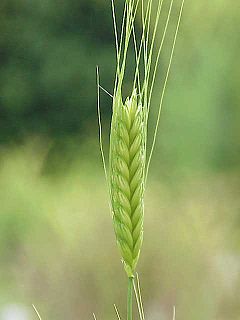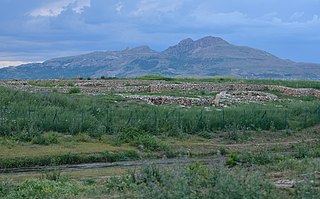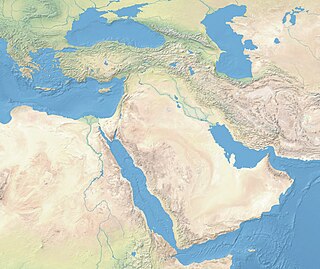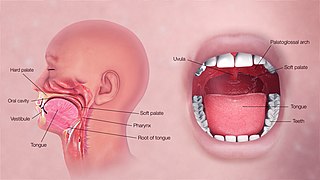
Zoo-archaeology, also known as faunal analysis, is a branch of archaeology that studies remains of animals from archaeological sites. Faunal remains are the items left behind when an animal dies. These include bones, shells, hair, chitin, scales, hides, proteins and DNA. Of these items, bones and shells are the ones that occur most frequently at archaeological sites where faunal remains can be found. Most of the time, a majority of these faunal remains do not survive. They often decompose or break because of various circumstances. This can cause difficulties in identifying the remains and interpreting their significance.

Einkorn wheat can refer either to the wild species of wheat, Triticum boeoticum, or to the domesticated form, Triticum monococcum. The wild and domesticated forms are either considered separate species, as here, or as subspecies: Triticum monococcum subsp. boeoticum (wild) and T. monococcum subsp. monococcum (domesticated). Einkorn is a diploid species of hulled wheat, with tough glumes ('husks') that tightly enclose the grains. The cultivated form is similar to the wild, except that the ear stays intact when ripe and the seeds are larger. The domestic form is known as "petit épeautre" in French, "Einkorn" in German, "einkorn" or "littlespelt" in English, "piccolo farro" in Italian and "escanda menor" in Spanish. The name refers to the fact that each spikelet contains only one grain.

In dentistry, calculus or tartar is a form of hardened dental plaque. It is caused by precipitation of minerals from saliva and gingival crevicular fluid (GCF) in plaque on the teeth. This process of precipitation kills the bacterial cells within dental plaque, but the rough and hardened surface that is formed provides an ideal surface for further plaque formation. This leads to calculus buildup, which compromises the health of the gingiva (gums). Calculus can form both along the gumline, where it is referred to as supragingival, and within the narrow sulcus that exists between the teeth and the gingiva, where it is referred to as subgingival.
Archaeogenetics is the study of ancient DNA using various molecular genetic methods and DNA resources. This form of genetic analysis can be applied to human, animal, and plant specimens. Ancient DNA can be extracted from various fossilized specimens including bones, eggshells, and artificially preserved tissues in human and animal specimens. In plants, Ancient DNA can be extracted from seeds and tissue. Archaeogenetics provides us with genetic evidence of ancient population group migrations, domestication events, and plant and animal evolution. The ancient DNA cross referenced with the DNA of relative modern genetic populations allows researchers to run comparison studies that provide a more complete analysis when ancient DNA is compromised.
The term bioarchaeology has been attributed to British archaeologist Grahame Clark who, in 1972, defined it as the study of animal and human bones from archaeological sites. Redefined in 1977 by Jane Buikstra, bioarchaeology in the United States now refers to the scientific study of human remains from archaeological sites, a discipline known in other countries as osteoarchaeology, osteology or palaeo-osteology. Compared to bioarchaeology, osteoarchaeology is the scientific study that solely focus on the human skeleton. The human skeleton is used to tell us about health, lifestyle, diet, mortality and physique of the past. Furthermore, palaeo-osteology is simple the study of ancient bones.

Ancient Maya cuisine was varied and extensive. Many different types of resources were consumed, including maritime, flora, and faunal material, and food was obtained or produced through strategies such as hunting, foraging, and large-scale agricultural production. Plant domestication concentrated upon several core foods, the most important of which was maize.
Stine Rossel was a Danish archaeologist. She was a postdoc and Instructor of Egyptology at the University of Copenhagen. Her interests included zooarchaeology, the effects of environmental change on animal use, and the rise of complex societies.

Çayönü Tepesi is a Neolithic settlement in southeastern Turkey which prospered from circa 8,630 to 6,800 BC. It is located forty kilometres north-west of Diyarbakır, at the foot of the Taurus mountains. It lies near the Boğazçay, a tributary of the upper Tigris River and the Bestakot, an intermittent stream.
Egypt has a long and involved demographic history. This is partly due to the territory's geographical location at the crossroads of several major cultural areas: North Africa, the Middle East, the Mediterranean and Sub-Saharan Africa. In addition, Egypt has experienced several invasions during its long history, including by the Canaanites, the Ancient Libyans, the Assyrians, the Kushites, the Persians, the Greeks, the Romans, and the Arabs.

Paleofeces are ancient human feces, often found as part of archaeological excavations or surveys. The term coprolite is often used interchangeably, although coprolite can also refer to fossilized animal feces. Intact feces of ancient people may be found in caves in arid climates and in other locations with suitable preservation conditions. They are studied to determine the diet and health of the people who produced them through the analysis of seeds, small bones, and parasite eggs found inside. The feces can contain information about the person excreting the material as well as information about the material itself. They can also be chemically analyzed for more in-depth information on the individual who excreted them, using lipid analysis and ancient DNA analysis. The success rate of usable DNA extraction is relatively high in paleofeces, making it more reliable than skeletal DNA retrieval.

Patrick Edward McGovern is the Scientific Director of the Biomolecular Archaeology Laboratory for Cuisine, Fermented Beverages, and Health at the University of Pennsylvania Museum in Philadelphia, where he is also an Adjunct Professor of Anthropology. In the popular imagination, he is known as the "Indiana Jones of Ancient Ales, Wines, and Extreme Beverages"

The Paleolithic dog was a Late Pleistocene canine. They were directly associated with human hunting camps in Europe over 30,000 years ago and it is proposed that these were domesticated. They are further proposed to be either a proto-dog and the ancestor of the domestic dog or an extinct, morphologically and genetically divergent wolf population.
Melinda A. Zeder is an American archaeologist and Curator Emeritus in the Department of Anthropology of the National Museum of Natural History, Smithsonian Institution. Her zooarchaeological research has revolutionized understandings of animal domestication.

Christina Warinner is an American anthropologist best known for her research on the evolution of ancient microbiomes. She is an Assistant Professor of Anthropology at Harvard University and the Sally Starling Seaver Assistant Professor at the Radcliffe Institute. Warinner is also a Research group leader at the Max Planck Institute for the Science of Human History in Jena, Germany.
Soro Mik'aya Patjxa is a high-altitude archaeological site located in the Ilave Basin in Peru, about 30 km (19 mi) west of the current shoreline of Lake Titicaca. Soro Mik'aya Patjxa was a seasonal residential site that was reused consistently by hunter-gatherers over a period of over a thousand years.

Anne C. Stone is an American anthropological geneticist and a Regents' Professor in the School of Human Evolution and Social Change at Arizona State University. Her research focuses on population history and understanding how humans and the great apes have adapted to their environments, including their disease and dietary environments. Stone is a Fellow of the American Association for the Advancement of Science and a Member of the National Academy of Sciences.
Michelle Alexander is a bioarchaeologist with an interest in multi-faith societies and is Senior Lecturer in Bioarchaeology at the University of York.

Near Eastern bioarchaeology covers the study of human skeletal remains from archaeological sites in Cyprus, Egypt, Levantine coast, Jordan, Turkey, Iran, Saudi Arabia, Qatar, Kuwait, Bahrain, United Arab Emirates, Oman, and Yemen.

The evolution of the human oral microbiome is the study of microorganisms in the oral cavity and how they have adapted over time. There are recent advancements in ancient dental research that have given insight to the evolution of the human oral microbiome. Using these techniques it is now known what metabolite classes have been preserved and the difference in genetic diversity that exists from ancient to modern microbiota. The relationship between oral microbiota and its human host has changed and this transition can directly be linked to common diseases in human evolutionary past. Evolutionary medicine provides a framework for reevaluating oral health and disease and biological anthropology provides the context to identify the ancestral human microbiome. These disciplines together give insights into the oral microbiome and can potentially help contribute to restoring and maintaining oral health in the future.
Malin Holst is a German bioarchaeologist, Director of York Ostoearchaeology Ltd. and a lecturer in the Department of Archaeology at the University of York.












